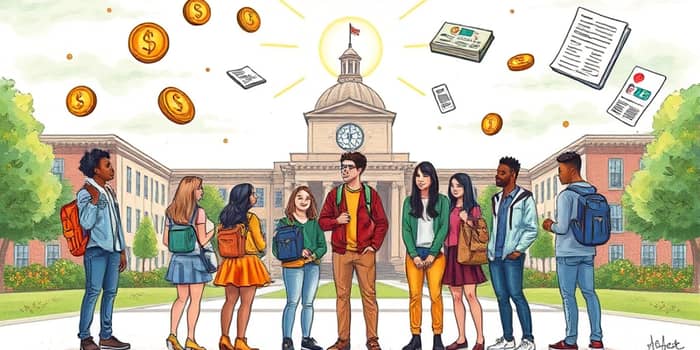Borrowing for college is one of the most significant financial decisions many young adults make. Understanding how student loans affect your overall financial aid package is critical to ensuring a positive outcome after graduation.
In 2025, federal aid policies and soaring debt levels underscore the need for careful planning. This article explores the latest trends, policy shifts, and practical strategies to navigate the complex world of financial aid and student loans.
The State of Student Loans in 2025
The total U.S. student loan debt has climbed back to $1.777 trillion, with federal loans accounting for roughly 93% of that burden. In the 2023-24 academic year, ten million students received federal aid, and nearly 17 million filed the FAFSA for the 2022-23 cycle.
Average undergraduate borrowers graduate with about $29,300 in debt, but this number varies widely by field of study. For instance, medical graduates average $264,000, and dental students around $296,000.
Rising interest accrual and resumed wage garnishment as of May 2025 highlight the importance of realistic repayment strategies. Without proactive planning, many borrowers face long-term financial stress.
Understanding Financial Aid Options
Federal financial aid comes in three primary forms:
- Grants and scholarships — gift aid that does not require repayment.
- Subsidized loans — government pays interest while you’re enrolled.
- Unsubsidized loans — interest begins accruing immediately.
In 2025, projected federal aid disbursements totaled $135 billion, with $40.6 billion in grants and $93.1 billion in new federal loans. However, Pell Grant funding may face a potential $10 billion shortfall by 2026, putting needy students at risk.
The FAFSA remains your gateway to most federal aid. Approximately 74% of filers are returning students, indicating that continued enrollment often depends on reliable financial assistance.
Policy Changes on the Horizon
The 2025 Budget Reconciliation Bill proposes significant shifts that could reshape financial aid:
- Elimination of subsidized loans, forcing students to accrue interest from day one.
- Stricter borrowing caps, such as a $50,000 lifetime limit for undergraduates.
- Higher cost-sharing by institutions, potentially reducing institutional grants.
Such changes could increase out-of-pocket expenses or force reliance on private loans, which often carry higher interest rates and fewer protections than federal programs.
Comparing Debt by Degree Type
Understanding how debt varies by program can inform your borrowing decisions. Consider this snapshot of average debt upon graduation:
Graduate and professional students generally face the highest borrowing amounts, making early awareness and targeted planning crucial before enrolling.
How Loans Shape Your Aid Package
Loans supplement grants and scholarships, but they also affect your overall financial profile. Institutions may reduce their own aid awards when federal loans cover larger portions of tuition, potentially leaving students with unmet needs.
Furthermore, borrowing more than necessary can harm your credit and limit post-graduation opportunities like homeownership. The average household carrying student debt owes about $55,777, and 30% of borrowers regret their decision to take on loans.
Making Informed Borrowing Decisions
Before signing on the dotted line, follow these steps to ensure you borrow responsibly:
- Estimate total costs — include tuition, fees, housing, and transportation.
- Maximize gift aid first — apply for scholarships and institutional grants.
- Borrow only what you need, up to federal limits.
- Complete entrance counseling and review loan terms carefully.
Develop a clear repayment strategy. Use budget tools to project monthly payments and explore income-driven repayment plans that tie payments to earnings.
Contact financial aid offices, nonprofit counselors, and online resources to stay updated on policy changes and available relief programs. Proactive engagement can prevent surprises when repayment begins.
Practical Tips for Borrowers
Embarking on the loan process can feel overwhelming. These practical tips can empower you:
1. Create a borrowing worksheet outlining each loan’s interest rate, balance, and repayment terms.
2. Set reminders for grace period end dates and payment due dates to avoid late fees or garnishment.
3. Consider paying interest while enrolled on unsubsidized loans to lower your principal balance.
4. Explore part-time work-study opportunities to reduce the amount you need to borrow.
Planning for a Secure Financial Future
Student loans can unlock educational opportunities, but they carry long-term responsibilities. By understanding the full impact of borrowing on your financial aid package and future finances, you can make choices that align with your goals.
Strive to balance the benefits of higher education with the realities of debt. Stay informed about legislative changes, seek professional guidance, and maintain open communication with loan servicers.
Ultimately, responsible borrowing and proactive planning can transform student loans from a burden into a strategic investment in your future.
References
- https://educationdata.org/financial-aid-statistics
- https://educationdata.org/student-loan-debt-statistics
- https://www.nerdwallet.com/article/loans/student-loans/data-2025-high-school-grad
- https://www.watermarkinsights.com/resources/blog/federal-student-aid-college-effects-2025-beyond/
- https://comptroller.nyc.gov/reports/student-loans-and-the-high-cost-of-higher-education/
- https://www.nerdwallet.com/article/loans/student-loans/student-loan-debt
- https://www.bc.edu/bc-web/offices/student-services/financial-aid/undergraduate/types-of-financial-aid.html
- https://www.studentloanprofessor.com/student-loan-debt-statistics/










